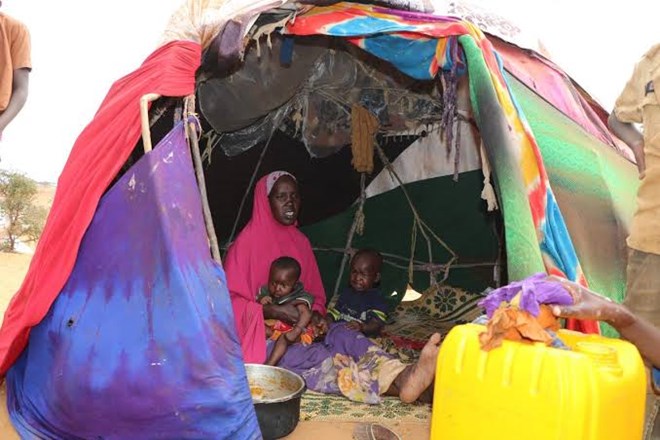
Friday March 4, 2022

Ninety per cent of Somalia is experiencing critical drought. To date, more than 4.3 million people are have been severely impacted, facing life-threatening water shortages and rising food prices.
Hundreds of thousands of people have already fled their homes, creating a displacement crisis, with numbers projected to rise to 1.4 million. The Norwegian Refugee Council (NRC) and partners are responding, but international support is falling short.
Wrapped in a pink hijab, Rahma Omar sits inside a makeshift shelter made of old clothes, sticks and ropes. It struggles to withstand strong gusts of wind and provides only a little protection from the sun and the heat.
In the past, she has earned enough money from farming to feed and protect her children. However, three failed rainy seasons have made this impossible.
"I had a big farm and livestock back in my village, which is around 220 kilometres away from here,” she says. “Everything was good for us. I was able to sustain my family and also feed my children without any difficulties.
"I had about 50 cows and 32 goats, and this was my family’s primary source of income. But the drought and the lack of rain made it difficult to feed my children.
“I lost all my livestock. I still recall that tragic time in our village, and our long journey to Kismayo town.”
In a country where the average income is just USD 870 a year, the loss of almost USD 15,000 worth of livestock – Rahma’s only source of income – will take years to recover.
A dangerous journey
Desperate for assistance, Rahma and her children left their home on a donkey cart. They were forced to undertake a dangerous journey through rural areas, across land fought over by government forces and Al Shabaab. Her last few remaining cattle accompanied them.
Four of Rahma’s children fell seriously ill due to malnutrition. “It was a horrific journey,” she says. “We slept on the roads, exposed to the risk of deadly animals. We could not bear the hunger. Sometimes we resorted to begging for food.”
Thankfully, all her children survived. But her remaining livestock did not. Some died along the way, and some had to be abandoned.
After the 220 km journey, Rahma decided to settle in Luglow settlement, on the outskirts of Kismayo town.
Luglow is now home to more than 21,000 drought-stricken people, many of them impoverished families, who have fled their rural homes. Across Somalia as a whole, more than 550,000 people have already been displaced.
Dozens of people, mostly mothers with their children, are arriving every day in Luglow.
"I decided to stop here in Luglow in the hope of getting some sort of humanitarian assistance, but so far, we haven’t received any support,” says Rahma.
Drought response efforts are underway by the government, the UN and partners, local communities, and NRC. We are working to support as many of Somalia’s vulnerable people as possible, prioritising access to clean water, food, emergency income and shelter.
However, funding for those in need is insufficient and arriving later than previous drought seasons.
“It is not too late to save lives”
While rains are forecast in April, the predictions are not positive. Somalia is potentially on track for a historic four-season drought; the longest stretch of poor rainfall since 1981.
"With the prospect of 1.4 million people who will have no alternative but to flee, it is critical we address the underlying problems – now – before more people are forced to move and their needs rise,” says NRC Somalia’s incident response manager, Nadeem Ilyas.
"This means ensuring people at risk, particularly in rural areas, have clean water to drink, food to eat, and a basic source of income during the drought. We must, at the same time, provide food, water and shelter to those who have no choice but to flee.”
In the face of drought, those at risk face food and water insecurity, malnutrition, rising commodity prices, crop and livestock losses, conflict, and violence (particularly women). As displacement increases and natural resources including water and pasture dwindle, conflicts have already begun to occur between different groups.
“Tragically, people are already suffering,” says Ilyas